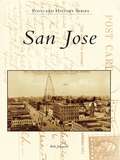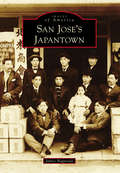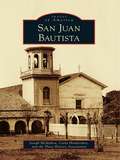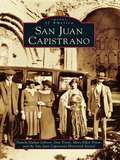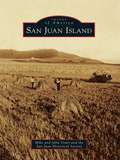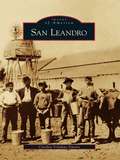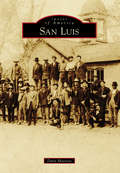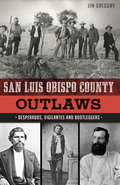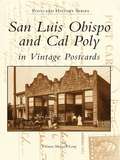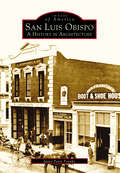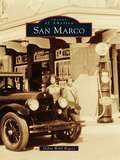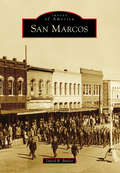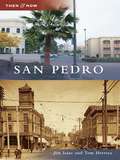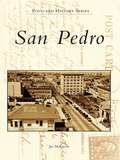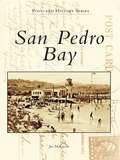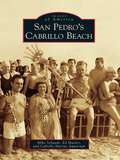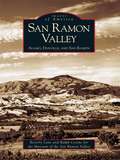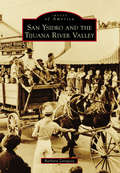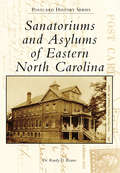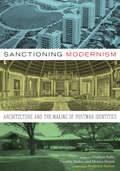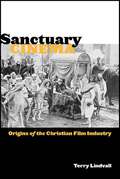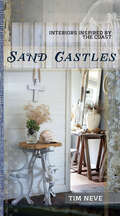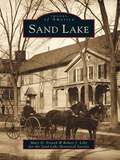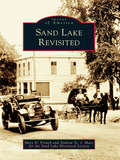- Table View
- List View
San Jose (Postcard History Series)
by Bob JohnsonFounded by the Spanish in 1777 to provide food for the military settlements in Monterey and San Francisco, San Jose is the oldest civilian settlement in California. After independence from Mexico, San Jose became the county seat of Santa Clara County and the first state capital. For many years, San Jose was the center of a rich farming community whose vistas of blooming orchards prompted the nickname "Valley of Heart's Delight." Following World War II, a massive transformation took place in the landscape and culture of San Jose and the surrounding area. Fields and orchards gave way to subdivisions, malls, freeways, and office buildings. The population grew from less than 100,000 to over a million as agriculture was supplanted by semiconductors and software development.
San Jose's Japantown (Images of America)
by James NagaredaThe Japanese started to arrive in San Jose, California, around 1890 in the Heinlenville area, which was once on the outskirts of the city. Many of the businesses that the Japanese opened would serve the needs of the growing Japanese population, who came to the Santa Clara Valley to take advantage of opportunities in the agricultural industry. Out of 46 Japantowns, only three remain in California. San Jose�s Japantown is unique in that it is the only surviving Japantown that has remained in its original location. Today, San Jose�s Japantown is a thriving and evolving mix of traditional and contemporary arts, culture, and lifestyle.
San Juan Bautista
by Plaza History Association Joseph Mcmahon Carla HendershotHidden among the rolling hills and picturesque valleys of California's coastal mountain range is the quiet mission town of San Juan Bautista. Forged by the San Andreas Fault, the same stunningenvironment that attracted Spanish missionaries to establish Mission San Juan Bautista in 1797 would invite multitudes of visitors and settlers during the first years of California's statehood. Bypassed by the railroad in the 1870s, the town saw its population dwindle and seemed likely to fade unnoticed into history. In the 1930s, the structures around the ancient mission plaza narrowly avoided decay and demolition. The community, with the plaza at its heart, embarked upon a slow but steadyrestoration and revival of its former splendor. Today both mission and town thrive as important cultural and spiritual centers.
San Juan Capistrano
by Don Tryon San Juan Capistrano Historical Society Pamela Hallan-Gibson Mary Ellen TryonThe legendary swallows aren't the only annual returnees to San Juan Capistrano. The great coastal mission draws more than 500,000 visitors a year into the southern reaches of Orange County. The most famous of all the missions in the California system established in the 18th century by Franciscan friar Junipero Serra, Mission San Juan Capistrano still contains the Serra Chapel, the oldest church in California, and the only building still standing where the good padre celebrated mass. But San Juan Capistrano is more than its well-known mission. Its epic story encompasses the rancho days and land barons, California statehood, the arrival of the San Diego Freeway in 1958, city incorporation in 1961, and recent growth from 10,000 residents in 1974 to 34,000 in 2004.
San Juan Island
by Julia Vouri San Juan Historical Society Mike VouriWith sheltered harbors, open prairies, and secluded woodlands, San Juan Island has been a magnet for human habitation for thousands of years. Salmon runs and rich soil promised not only an abundant food source but also a good living for those willing to work hard. But it was not until the islands became the focus of an international boundary dispute between Great Britain and the United States in the late 1850s that San Juan Island drew the attention of Europeans and Americans. These newcomers watched how Coast Salish and Northwest Coast peoples harvested natural resources and adapted their techniques. Settlers and Indians sometimes intermarried, and many of their descendants remain to this day. San Juan Islanders of all generations have worked hard to preserve their home, thus maintaining a sense of place that is as evident today as it was when the first canoes came ashore.
San Leandro
by Cynthia Vrilakas SimonsCherry festivals, Holy Ghost festas, oyster pirates, tractors, squatters, Portuguese--the many threads of San Leandro's past have woven a rich historical tapestry underlying the modern city of San Leandro. These 15 square miles between San Francisco Bay and the East Bay hills have been an Ohlone village, a Spanish rancho, a small farm town, the Portuguese capital of the West, an industrial center, and a major metropolitan suburb as a succession of new people has transformed the area.
San Luis
by Dana MaestasEstablished on April 5, 1851, Colorado's oldest town, San Luis de la Culebra, remains remarkably true to its heritage. Nestled below the Sangre de Cristo Land Grant in the San Luis Valley, San Luis and its descendants sustain a way of life and preserve a culture in this high, isolated desert region. Eighteen men migrated north from New Mexico into the northernmost area of Spanish exploration in the mid-1800s to settle San Luis along the Culebra River. These pioneering families brought their use of communal land and water and a language dating back to 16th-century Castilian Spain. They carried on a deep faith from the Old World into the New. The traditions of San Luis and the surrounding villages--Chama, San Pablo, San Pedro, San Francisco, and San Acacio--continue today among the young and old who remain the keepers of culture.
San Luis Obispo County Outlaws: Desperados, Vigilantes and Bootleggers (True Crime)
by Jim GregoryCalifornia was a wild and lawless place in the 1850s, and San Luis Obispo County was no exception. Outlaws and bandits passed along the El Camino Real, now Highway 101, leaving a trail of victims. Despite attempts to stem the tide of crime with a vigilante committee and a string of executions, notorious men continued to be drawn to the central coast well into the next century. The James brothers, the Daltons and even Al Capone made their mark here, while lawmen worked to tame this piece of the western frontier. Author Jim Gregory details nefarious activities lost to time.
San Luis Obispo and Cal Poly in Vintage Postcards
by Thomas Maxwell-LongAlong the California coastline lies the community of San Luis Obispo; a town just as rich in history as it is in beauty. Situated almost directly between Los Angeles and San Francisco, San Luis Obispo was first inhabited by the Chumash and Salinan Indians in 1400 B.C. It took almost 3,000 years before its majestic landscape was encountered byEuropean explorers.
San Luis Obispo: A History in Architecture
by Janet Penn FranksSan Luis Obispo was founded in 1772 as a mission in the foothills of the Santa Lucia Mountains on California's Central Coast. The city that grew from a rustic pueblo, with its scattering of adobe buildings, today has a wealth of architectural styles. From the simple barns of the outlying farm community, to the grand hotels and lively saloons kept busy by the Southern Pacific Railroad depot, and back full circle to the Mission Revival style edifices of California Polytechnic State University, San Luis Obispo's architecture has echoed its history. Motor travel brought the world's first motel to this half-way point on California's historic Highway 101, and the famously zany tourist attraction, the Madonna Inn.
San Marco
by Debra Webb RogersDecades before Walt Disney's dream took root in central Florida, tourists flocked to a place on the banks of the St. Johns River known simply as South Jacksonville. Although small and rural, it played a large part in the history of Florida, helping establish a premier tourist destination. South Jacksonville evolved into San Marco, whose unique history rivals anything found in a best-selling novel. That history includes steamships and bridges, ostriches and alligators, sharpshooters and daredevils, train wrecks, haunted theaters, sprawling plantations, Oriental gardens, "The Coney Island of the South," Creature from the Black Lagoon, Babe Ruth, John Phillip Sousa, Tom Mix, and an elephant named Toddles. All played a part in the rich and varied history that is San Marco.
San Marcos
by San Marcos Historical Society Charlie MusserAccording to legend, the name San Marcos can be attributed to a group of Spaniards who, while out on a mission to capture suspected horse thieves, accidently stumbled upon a beautiful "little valley" on the feast day of St. Mark. This little valley would remain sparsely populated for years to come, as a Mexican land grant tenanted by vaqueros, an agricultural salvation for homesteading early Californians, and the site of small towns that would nearly disappear between the pages of history. With the arrival of the Santa Fe Railroad, eventual official incorporation in 1963, and continuous progression today, San Marcos has formed an identity as a prospering and growing community that still retains the feel of a rural small town.
San Marcos (Images of America)
by David R. ButlerSan Marcos, Texas, permanently settled in 1846, was founded by former members of John C. Hays's company of Texas Rangers. The town was designated the county seat of Hays County by the Texas legislature in 1848 and was formally laid out in 1851. A center for local commerce associated with cattle and cotton production, San Marcos became an educational center with the chartering in 1899 and subsequent opening in 1903 of the Southwest Texas State Normal School. The normal school is now Texas State University, the fourth largest university in Texas with more than 36,000 students. This volume tells the story of a formerly sleepy college town on the edge of the Texas Hill Country that has become the fastest-growing city in the United States.
San Pedro
by Jim Isaac Tom HerreraSan Pedro was incorporated into the City of Los Angeles in 1909, and grew into one of the world's strategic international ports. The dredging and backfilling of berths and canals have been mirrored in town through the decades as landmarks were demolished, streets altered, and some structures steadfastly maintained.
San Pedro
by Joe MckinzieArcadia Publishing's second collection of postcard images concerning the Los Angeles Harbor community of San Pedro follows the 2005 Postcard History Series volume San Pedro Bay. Where that work concentrated on the harbor and water aspects of the colloquially known "Peedro," this new volume looks at the town and its development, buildings, businesses, streetscapes, and residences. The port village and town that grew from it has a rich and varied past with vital influence on the histories of the city of Los Angeles and California, and others no less epic than the sagas of the U.S. military, American labor unions, and world cargo shipping.
San Pedro Bay
by Joe MckinzieThe name "San Pedro Bay" meant Los Angeles Harbor through the 20th century, but the vestiges of that original, rustic, fishing village-like identity still cling to the port community that, through its proximity to the city of Los Angeles, grew into one of the world's largest centers of importing and exporting. The bay has served commercial fishermen, the U.S. Army, Navy, Marine Corps, and Coast Guard, the sailing yachts of the very wealthy, and the dinghies of the disenfranchised. Today, tugboats guide gargantuan oceangoing cargo ships under the towering gantry cranes for off-loading, and enormous cruise ships call the Port of Los Angeles home.
San Pedro's Cabrillo Beach
by Cabrillo Marine Aquarium Mike Schaadt Ed MastroNamed after the famous European explorer Juan Rodriguez Cabrillo, Cabrillo Beach in San Pedro is a recreational complex established in 1927 and located at the foot of one of the world's largest breakwaters protecting the Port of Los Angeles. A regional destination for beachgoers, the wave-swept Cabrillo attracts beachcombers to the tide pools in the adjacent rocky shores of the rugged Palos Verdes Peninsula. During spring and summer, onlookers watch the grunion mate and lay their eggs in the outer beach's wet sand. The protected beach has long been popular with young families who enjoy the calm harbor waters. A public boat launch allows easy access, and the breakwater's boulders have traditionally attracted fishermen and pelicans. Many of the million annual beach visitors enjoy exploring local marine life at the Cabrillo Marine Aquarium, Los Angeles's regional clearinghouse for ocean issues, which began in 1935 as the Cabrillo Marine Museum in the Cabrillo Beach Bathhouse.
San Ramon Valley: Alamo, Danville, and San Ramon
by Ralph Cozine Beverly Lane Museum of the San Ramon ValleThe San Ramon Valley stretches for 20 beautiful miles under the shadow of Mount Diablo and includes the bustling communities of San Ramon, Alamo, and Danville. Some 113,000 people make their homes here in a scenic area of open spaces, gracious homes, and tree-lined streets. Also here are major business hubs and the winding Interstate 680 freeway. Of course, this valley wasn't always so populous. In the 1850s, while nearby San Francisco boomed and Oakland grew up, this valley remained rural. Mount Diablo became an important early survey marker during California's gold rush, but only in recent decades have the early ranchos and small villages given way to the modern cities we know today.
San Ysidro and The Tijuana River Valley
by Barbara ZaragozaIn 1851, surveyors placed a marble obelisk on a mesa overlooking the Pacific Ocean, which demarcated the United States-Mexico boundary line. Tourists flocked to the region alongside land speculators who envisioned upscale hotels, resorts, and spas. Two decades later, an East Coast journalist, William Smythe, established a utopian agricultural colony in what is today San Ysidro. Tourists began to cross the border in droves when Tijuana earned the reputation as "vice city." Racetrack, saloon, and gambling house employees settled in San Ysidro, while ranchers in the Tijuana River Valley bred horses for the racetracks. Dairy and vegetable farmers also moved in, taking advantage of the year-round mild weather. By the 1970s, suburban development and greater restrictions to the flow of people at the border meant the area became a predominantly Spanish-speaking community. The Port of Entry at San Ysidro also became the largest in the world, accommodating over 47 million people annually.
Sanatoriums and Asylums of Eastern North Carolina (Postcard History Series)
by Dr Randy KearnsFrom Wilmington, Fayetteville, Greenville, New Bern, Elizabeth City, Wilson, Kinston, Goldsboro, and many points in between, this book offers a brief look at many of the historical asylums and sanatoriums, as well as temporary hospitals of war and disaster, in Eastern North Carolina. It shows what they were and what they became as they transformed into the great hospitals of today. Many of these old buildings have long since been torn down or reused in a variety of ways seldom connected to their past. This book provides a glimpse of these great buildings, several of their artifacts, and images of what health care used to be in Eastern North Carolina and the role medicine has played as the region has grown.
Sanctioning Modernism: Architecture and the Making of Postwar Identities (Roger Fullington Series in Architecture)
by Vladimir Kulić, Timothy Parker, and Monica PenickIn the decades following World War II, modern architecture spread around the globe alongside increased modernization, urbanization, and postwar reconstruction—and it eventually won widespread acceptance. But as the limitations of conventional conceptions of modernism became apparent, modern architecture has come under increasing criticism. In this collection of essays, experienced and emerging scholars take a fresh look at postwar modern architecture by asking what it meant to be &“modern,&” what role modern architecture played in constructing modern identities, and who sanctioned (or was sanctioned by) modernism in architecture. This volume presents focused case studies of modern architecture in three realms—political, religious, and domestic—that address our very essence as human beings. Several essays explore developments in Czechoslovakia, Romania, and Yugoslavia and document a modernist design culture that crossed political barriers, such as the Iron Curtain, more readily than previously imagined. Other essays investigate various efforts to reconcile the concerns of modernist architects with the traditions of the Roman Catholic Church and other Christian institutions. And a final group of essays looks at postwar homebuilding in the United States and demonstrates how malleable and contested the image of the American home was in the mid-twentieth century. These inquiries show the limits of canonical views of modern architecture and reveal instead how civic institutions, ecclesiastical traditions, individual consumers, and others sought to sanction the forms and ideas of modern architecture in the service of their respective claims or desires to be modern.
Sanctuary Cinema: Origins of the Christian Film Industry
by Terry LindvallWinner of the Religious Communication Association Book of the Year Award for 2008Sanctuary Cinema provides the first history of the origins of the Christian film industry. Focusing on the early days of film during the silent era, it traces the ways in which the Church came to adopt film making as a way of conveying the Christian message to adherents. Surprisingly, rather than separating themselves from Hollywood or the American entertainment culture, early Christian film makers embraced Hollywood cinematic techniques and often populated their films with attractive actors and actresses. But they communicated their sectarian message effectively to believers, and helped to shape subsequent understandings of the Gospel message, which had historically been almost exclusively verbal, not communicated through visual media.Despite early successes in attracting new adherents with the lure of the film, the early Christian film industry ultimately failed, in large part due to growing fears that film would corrupt the church by substituting an American “civil religion” in place of solid Christian values and amidst continuing Christian unease about the potential for the glorification of images to revert to idolatry. While radio eclipsed the motion picture as the Christian communication media of choice by the 1920, the early film makers had laid the foundations for the current re-emergence of Christian film and entertainment, from Veggie Tales to The Passion of the Christ.
Sand Castles: Interiors Inspired by the Coast
by Tim NeveIn this beautifully illustrated book, interiors stylist Tim Neve explores a selection of extraordinary homes. Five eclectic chapters feature many personal "sand castles" inspired by the coast: from the elegant, salt-bleached driftwood neutrals of "Beachcomber" to the faded sunshine yellows and retro lollipop zing of "Endless Summer" and the rich peacock-colored velvets and time-worn vintage collections of the "Bohemian" home. Neve also offers a wealth of practical advice on how to create mood boards and color palettes, and use statement pieces and found objects to create your own personal design style.
Sand Lake
by Mary D. French Robert J. Lilly Sand Lake Historical SocietySand Lake Township lies just south of Troy and east of Albany. This community was a center of water-powered industry in the late 1800s and early 1900s. Dams on Crystal, Glass, and Burden Lakes provided waterpower for mills along the Wynantskill and finally for the largest waterwheel in North America at Burden Iron Works in Troy. When the railway arrived, the township with its seven lakes and numerous hotels blossomed into a tourist destination. In Sand Lake you will find Dr. Smith Boughton as "Big Thunder" in the Anti-Rent Wars of the mid-1800s, coded messages issued from church pulpits for transporting slaves via the Underground Railroad, Uline's Infallible Remedy cure-all, the Park Pharmacy soda fountain manned by teenager (later comedian) Jerry Lewis, and Gov. TheodoreRoosevelt at Brown's Crooked Lake House.
Sand Lake Revisited (Images of America)
by Mary D. French Sand Lake Historical Society Andrew St. MaceSand Lake Revisited provides a fresh perspective on the history of an eastern New York State township, located just south of Troy and east of Albany. It features an outpouring of vintage images and storiesthat have come to light since the first photographic history of Sand Lake was published. Pictured are the beach that was known as Upstate Coney Island, lovely tourist lodgings adjacent to the town's seven lakes,long johns manufactured at Faith Mills, and a hometown Vietnam War hero who saved the lives of 14 men.
